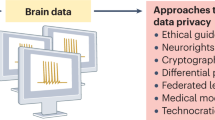Abstract
In the last decades, novel neurotechnologies are enabling the collecting and analyzing of neuronal data as well as the targeted alteration of brain activity. While this progress has the potential to help many patients with neurological or mental diseases, it also raises significant ethical and societal consequences, putting the mental privacy, identity and agency of citizens potentially at risk. As one approach to provide ethical guidelines to novel neurotechnologies, we propose a “Technocratic Oath,” as a pledge of simple, fundamental ethical core principles to be adopted by Neurotechnology developers and the industry. Our proposed Technocratic Oath is anchored on seven ethical principles: beneficence, non-maleficence, autonomy, justice, dignity, privacy and transparency. The Technocratic Oath is modelled after the Hippocratic Oath, a pledge taken by all physicians as they enter the medical profession. While legally non-binding, the professional weight of the Hippocratic Oath has historically led to responsible practices in the world of medicine. Similarly, the Technocratic Oath could help establish and propagate a core of ethical principles to ensure responsible innovation and to protect the fundamental human rights of patients and consumers.
Access this chapter
Tax calculation will be finalised at checkout
Purchases are for personal use only
Similar content being viewed by others
References
Anumanchipalli K, Chartier J, Chang E (2019) Speech synthesis from neural decoding of spoken sentences. Nature 568:493–498
Aparisi A (2006) Ética y deontología para juristas. Eunsa, Pamplona
Askitopoulou H, Vgontzas AN (2017) The relevance of the hippocratic oath to the ethical and moral values of contemporary medicine. Part I: the hippocratic oath from antiquity to modern times. Eur Spine J. https://doi.org/10.1007/s00586-017-5348-4
Berger H (1929) Über das Elektrenkephalogramm des Menschen. Arch Psychiatr Nervenkr 87(1):527–570
Britton JW, Frey L, Hopp J, Korb P, Koubeissi M, Lievens W, Pestana-Knight E, St. Louis E (2016) Electroencephalography (EEG): An Introductory Text and Atlas of Normal and Abnormal Findings in Adults, Children, and Infants
Caton R (1970) The electric currents of the brain. Am J EEG Technol 10(1):12–14
Fothergill W, Knight B, Stahl I, Ulnicane B (2019) Responsible data governance of neuroscience big data. Front Neuroinformatics. https://doi.org/10.3389/fninf.2019.00028
Gamboa-Bernal GA (2020) Importancia e implicaciones de un juramento en tiempos de pandemia. Persona y Bioética 24(1):5–13. https://doi.org/10.5294/pebi.2020.24.1.1
Ienca M, Andorno R (2017) Towards new human rights in the age of neuroscience and neurotechnology. Life Sci Soc Policy 13(1):5
Insel TR, Landis SC, Collins FS (2013) The NIH BRAIN Initiative. Science 340(6133):687–688. https://doi.org/10.1126/science.1239276
Jobin A, Ienca M, Vayena E (2019) The global landscape of AI ethics guidelines. Nat Mach Intell 1(9):389–399. https://doi.org/10.1038/s42256-019-0088-2
Kaiser UB (2014) Editorial: advances in neuroscience. the brain initiative and implications for neuroendocrinology. Mol Endocrinol 28(10):1589–1591
Klaes C (2018) Invasive brain-computer interfaces and neural recordings from humans. In: Manhan-Vaughan D (ed) Handbook of in vivo neural plasticity techniques. Academic Press, San Diego, pp 527–539
Lemarchand G (2010) Ciencia para la paz y el desarrollo: el caso del Juramento Hipocrático para Científicos, UNESCO. http://www.centropaz.com.ar/publicaciones/paz/paz35.pdf#page=pag71-73
Moses DA, Leonard MK, Makin JG, Chang EF (2019) Real-time decoding of question-and-answer speech dialogue using human cortical activity. Nat Commun 10(1). https://doi.org/10.1038/s41467-019-10994-4
Musk E (2019) An integrated brain-machine interface platform with thousands of channels. BioRxiv, 703801
NIH (2021) https://braininitiative.nih.gov/
RAE (2001) Las definiciones de los términos “juramento,” “lealtad,” “fidelidad,” “honor” de la vigésimo segunda edición del Diccionario de la Real Academia de la Lengua del año 2001
Roelfsema PR, Denys D, Klink PC (2018) Mind reading and writing: the future of neurotechnology. Trends Cogn Sci 22(7):598–610
Salles A et al (2019) NeuroView the human brain project : responsible brain research for the benefit of society neuroview. Neuron 101(3):380–384
Sanchez-Salvatierra JM, Taype-Rondan A (2018) Evolution of the hippocratic oath: what has changed and why? Rev Med Chile 146(12):1498–1500
Shen BYH (2013) US brain project puts focus on ethics. Nature 500:6–7
Sulmasy DP (1999) What is an oath and why should a physician swear one? Theor Med Bioeth 20:329–346
tech@facebook (2020) https://tech.fb.com/
Thimot J, Kenneth LS (2017) Wirelessly powered implants. Nat Biomed Eng 1:1–2
Ujwal C, Birbaumer N, Ramos-Murguialday R (2016) Brain–computer interfaces for communication and rehabilitation. Nat Rev Neurol 12(9):513–525. https://doi.org/10.1038/nrneurol.2016.113
Velasquez-Manoff M (2020) The mind readers. The New York Times
Wyrwicka W, Sterman M (1968) Instrumental conditioning of sensorimotor cortex EEG spindles in the waking cat. Physiol Behav 3:703–707
Yuste R, Bargmann CI (2017) Towards a global brain initiative. Cell 168:956–959
Yuste R et al (2017) Four ethical priorities for neurotechnologies and artificial intelligence. Nature 551:159–163
Acknowledgements
Supported by the IBM—Columbia University Data Science Institute grant (“Noninvasive Brain Computer Interface Data: Ethical and Privacy Challenges;” R. Yuste and Ken Shepard, PIs.), NSF DBI 1644405 (“Coordinating Global Brain Project;” R. Yuste and C. Bargmann, PIs.) and of the Precision Medicine & Society Program, from Columbia University College of Physicians & Surgeons (“Genomic Data Regulation: A Legal Framework for NeuroData Privacy Protection;” R. Yuste, and G. Hripcsak, PIs), FONDECYT Postdoctorado 3190914 to Leonie Kausel.
Author information
Authors and Affiliations
Corresponding author
Editor information
Editors and Affiliations
Rights and permissions
Copyright information
© 2022 The Author(s), under exclusive license to Springer Nature Switzerland AG
About this chapter
Cite this chapter
Álamos, M.F. et al. (2022). A Technocratic Oath. In: López-Silva, P., Valera, L. (eds) Protecting the Mind. Ethics of Science and Technology Assessment, vol 49. Springer, Cham. https://doi.org/10.1007/978-3-030-94032-4_14
Download citation
DOI: https://doi.org/10.1007/978-3-030-94032-4_14
Published:
Publisher Name: Springer, Cham
Print ISBN: 978-3-030-94031-7
Online ISBN: 978-3-030-94032-4
eBook Packages: Religion and PhilosophyPhilosophy and Religion (R0)



